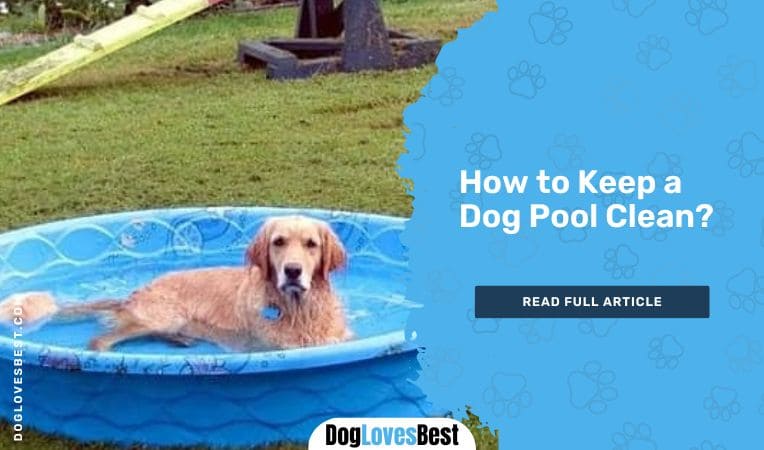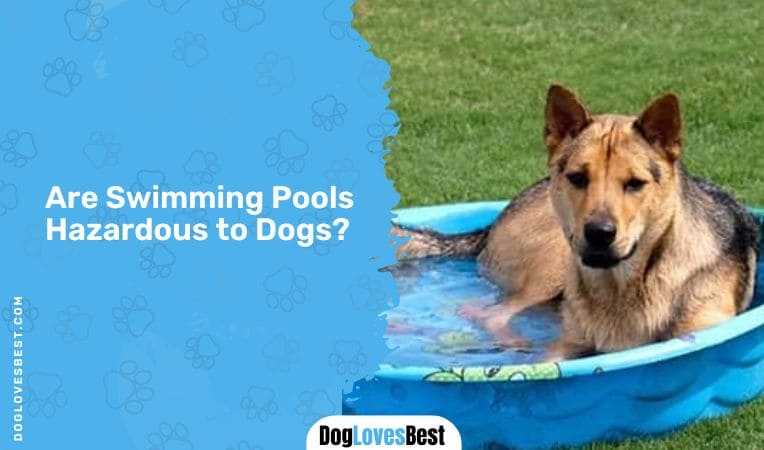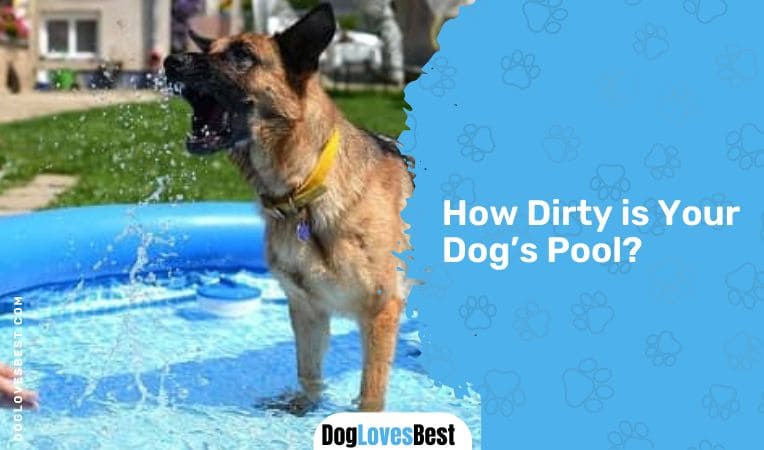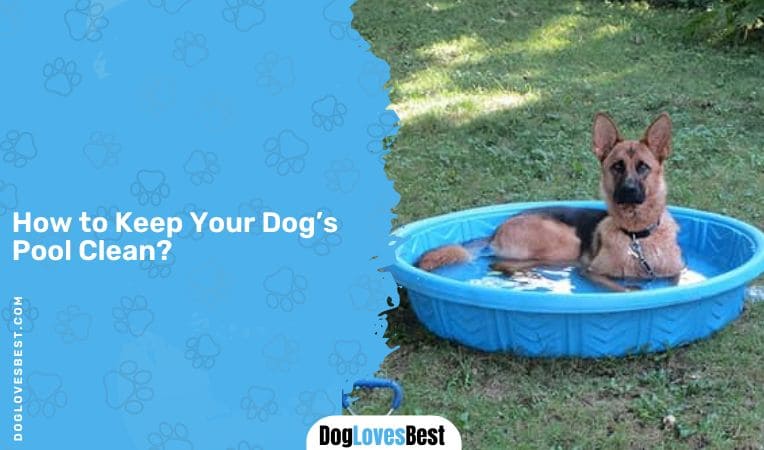Hot summers and scorching heats call for a swim. And swimming is more fun when it’s with your pooch. But all dogs do not find it very feasible to swim in a ground pool.

If your dog’s a swimmer and loves chilling in the pool, then getting a dog pool is a feasible option. But a dog pool is prone to getting dirty if not cleaned on a regular basis.
Moreover, dogs aren’t natural swimmers and are not used to the pool environment. Let’s discuss, how to keep a dog pool clean.
We consider a few factors before your pooch is ready for a clean and perfect swim.
Are Swimming Pools Hazardous to Dogs?
Swimming is a great exercise, be it for humans or pets. Indulging in swimming is definitely advisable but is swimming really safe for dogs?

Dogs are not natural swimmers but can be trained to swim. This requires a lot of patience and practice. Some dogs are quick learners while some take their own time. Eventually, it is great when your pet finally learns to swim and enjoys his water time with you.
Swimming can help your dogs in several ways. It helps them tone their muscles, increase stamina, and stay fit. However, for them to have these benefits they should have a clean swimming environment.
Moreover, cleaning a dog swimming pool is quite tasking and not desirable by many dog owners.
How Dirty is Your Dog’s Pool?
If you plan on a dip with your pooch, you need to ensure how much of an expert your dog is at swimming. A specialized dog pool or kiddie pool for your pet is a great idea.
These are much better than ground pools and there are fewer chances of your dog drowning into the pool as these pools are small.

However, they are subject to getting dirty easily if not attended regularly. What if your dog poops or pees in the pool? Also, if you leave the water unattended and stagnant for days together, it can end up cultivating algae and bacteria.
Dog pools are susceptible to cultivating bacteria like E. coli, Rotavirus, Salmonella, and Shigella. These can cause gastrointestinal disorders if your dog ends up drinking the pool water.
On a worse note, it can also end up growing Adenovirus which can cause respiratory and gastrointestinal infections. A dog pool may also consist of dog hair and debris which can cause allergies and rashes to your pooch.
How to Keep Your Dog’s Pool Clean?

So the question arises, how to keep your dog pool clean. Some people may think it is quite a task. Cleaning a dog pool may end up taking half your day. But, just as you clean the swimming pool for your baby, a dog swimming pool demands equal care and cleaning. We suggest you some easy tips and tricks to keep your dog’s pool clean and ready for a perfect dip.
- Replace the Water
Clean the water and replace it with fresh water each time your dog uses the swimming pool. Stagnant water attracts more bugs and mosquitoes and leads to the formation and cultivation of algae inside the pool.
This can make the water toxic and not safe for your dog to swim. As soon as your dog is done swimming, empty the contents of the pool. Some pools have built-in filters to filter the water automatically and remove dog hair and debris. - Clean the Pool Surface
Scrub the walls and surface of the pool by using an antibacterial solution and scrubber. Sometimes dog pools tend to have dog hair and dirt from water stuck onto the walls of the dog pool which can end up dirtying the water.
Make sure to clean them all from the crevices using a good scrubber. - Use Hose Spray
The water force coming from the hose spray is a big help to clean the dirt off the swimming pool. Allow the pool to dry completely. This is a quick and easy way to clean the swimming pool.
Although, it is advisable to use a soap solution along with the hose pipe for efficiently removing dirt and dog hair. - Add Chlorine
Chlorine is known for its anti-bacterial properties. But in some cases, dogs may turn out to be allergic to chlorine. Excess of chlorine and harmful chemicals tend to cause skin rashes and dryness.
Dog skin is extremely sensitive and a dog owner needs to take care of these factors before using chlorine to clean pool water.
The concentration of chlorine depends upon the amount of water in the pool. Dog pools are usually small and hence the amount of water is very less than normal ground pools. Hence, slight amounts of chlorine are sufficient.
Chlorine can cause dryness and skin rashes to your pet if used regularly and hence cannot be a regular solution to cleaning a dog pool. Using it occasionally as a disinfectant is advisable. - Chlorine Shocks
Chlorine acts as a good disinfectant but certain bacteria remain in the water, in spite of adding chlorine in suitable concentrations. What’s suggested in that case is chlorine shocks.
You can increase the chlorine concentration levels. This automatically ends up killing bacteria and algae because of the sudden increase in concentration.
This not only cleans the water but also the microbes stuck on the crevices and surface of the dog swimming pool. The ideal chlorine concentration should be 3-4 ppm before your dog can reenter the pool. - Clean the Dog Pool Toys
Having a few toys that give your dog company in the pool is a great thought. But if you plan to keep the pool clean, then cleaning the toys is equally important. Dogs can chew or lick onto those toys.
You could imagine how harmful it would that get if it is floating around with the dirty water in the swimming pool. It is equally susceptible to cultivating molds and bacteria.
Firstly, make sure to get toys that are of good quality and do not wear off easily in water. The toys should be removed as soon as your dog is done playing with them.
Don’t allow them to float in the pool for days together as they can end up developing germs. It can be cleaned with a mild disinfectant or warm water. Allow it to dry well before your dog plays with it the next time. - De-shed Your Dog
Groom your dog well before he enters the pool. There are various grooming brushes and grooming devices available. Certain dog breeds are long-haired and possess a dense coat.
There is nothing worse than having to clean hair from the swimming pool. Keeping your dog groomed beforehand can help you save a lot of cleaning efforts later. - Use a Pool Sweep
This is just like using a Vacuum cleaner for your dog pool. The pool sweep works on a suction pump that sucks all the debris and dirt, including dog hair from the swimming pool.
This debris gets collected in a skimmer basket that needs to be emptied from time to time. These pumps work efficiently and are good for cleaning small areas like a dog pool
The Final Note
Swimming is a great way of spending time with your pet. It is a great form of exercise but not safe to be carried out in a dirty dog pool. Dog pools are small and not very difficult to clean.
All you need is a little patience and a few steps to follow before you get a spic and span pool for your pet.
Certain basic protocols that we ideally follow for a kiddie pool like replacing the water, washing the pool with a hose spray, mildly chlorinating the water and maintaining certain precautions help in increasing the durability of the pool.
A dog pool can be taken care of in a similar way. Maintaining your poochie’s pool lets him have a healthy and happy swim time with you.
After all, they are just like kiddies too, aren’t they?
References:
- Vogelsang, J. D. (2021, June 30). Chlorine in Pools: Is it Safe for Pets? PetMD. Retrieved August 5, 2022, from https://www.petmd.com/dog/seasonal/chlorine-pools-it-safe-pets
- M. (2022, July 22). Keep It Cool This Summer: Tips For Taking Dogs Swimming. CVMBS News. Retrieved August 5, 2022, from https://vetmed.tamu.edu/news/pet-talk/taking-dogs-swimming/
- The dos and donâts of dog water safety. (n.d.-c). Vca. Retrieved August 5, 2022, from https://vcahospitals.com/shop/articles/the-dos-and-don-ts-of-dog-water-safety
- Hofmeister, A. S. (2006, October 15). Toxicosis associated with ingestion of quick-dissolve granulated chlorine in a dog. AVMA. https://avmajournals.avma.org/view/journals/javma/229/8/javma.229.8.1266.xml

Dwana is our best team member when it comes to taking care of pets on daily basis. This is because she used to be a full-time pet sitter before joining DogLovesBest. Besides contributing her precious knowledge on dog care tips and everyday-use pet products, she still does dog walking as part of her hobby in her free time.
